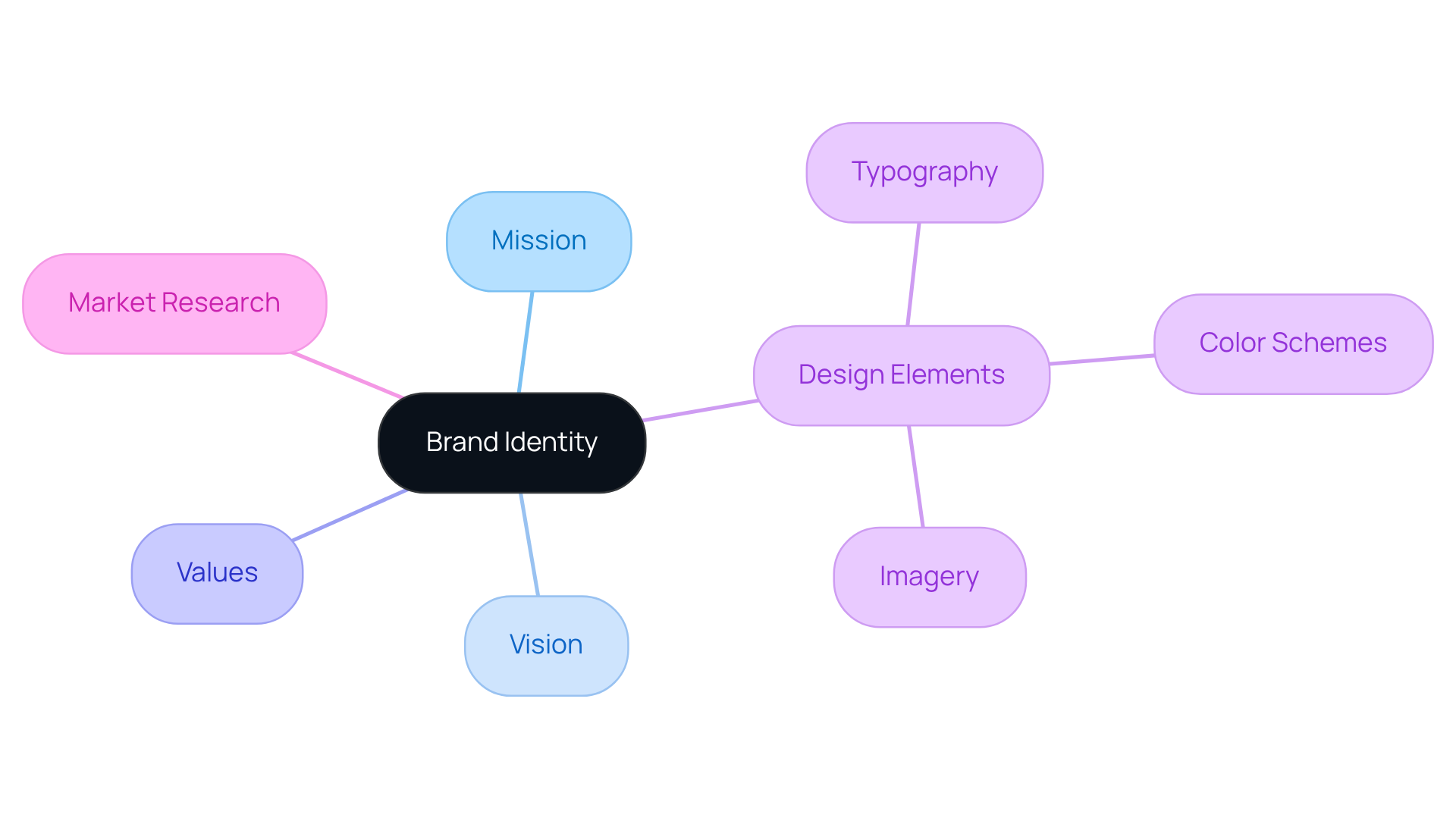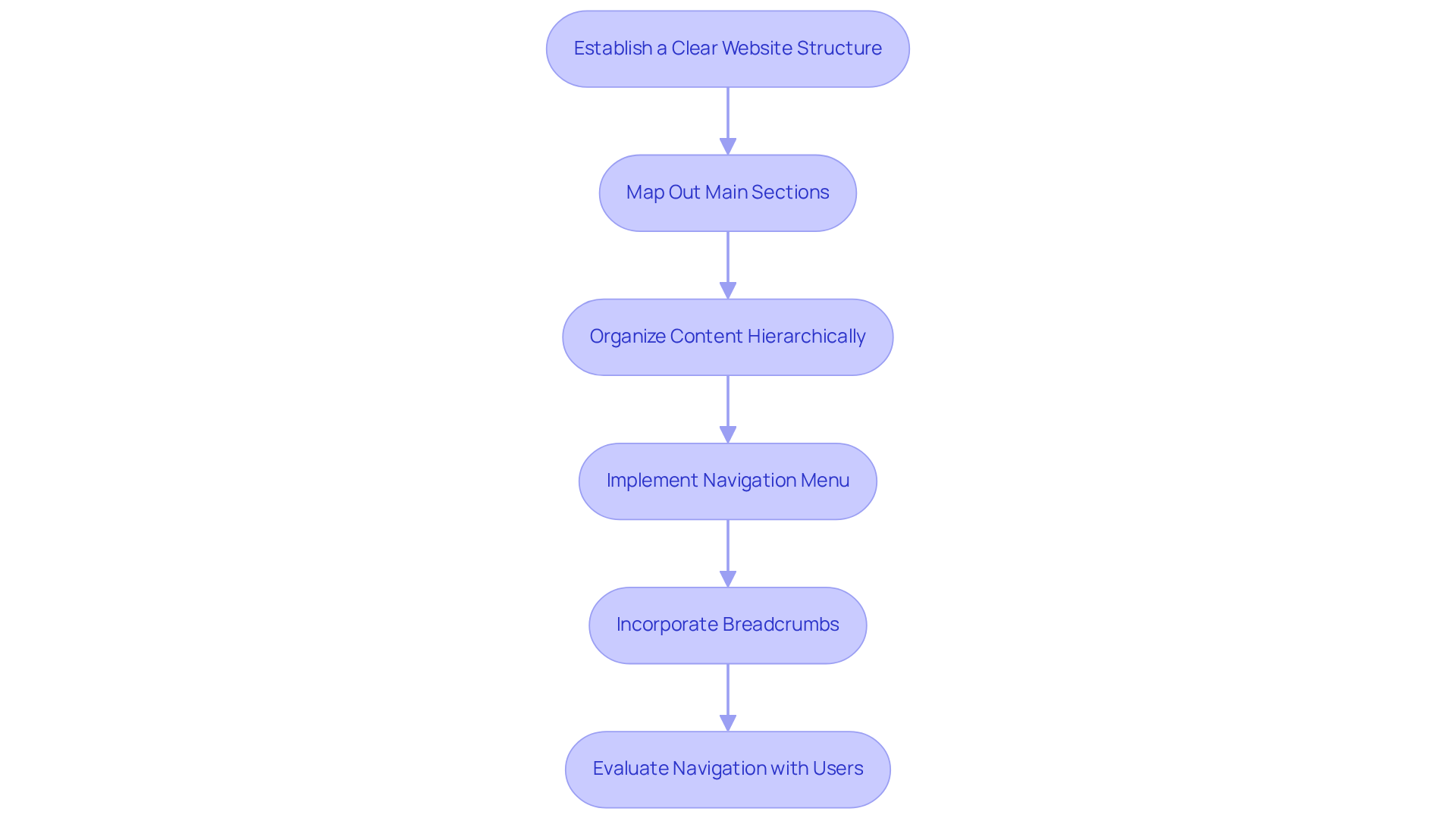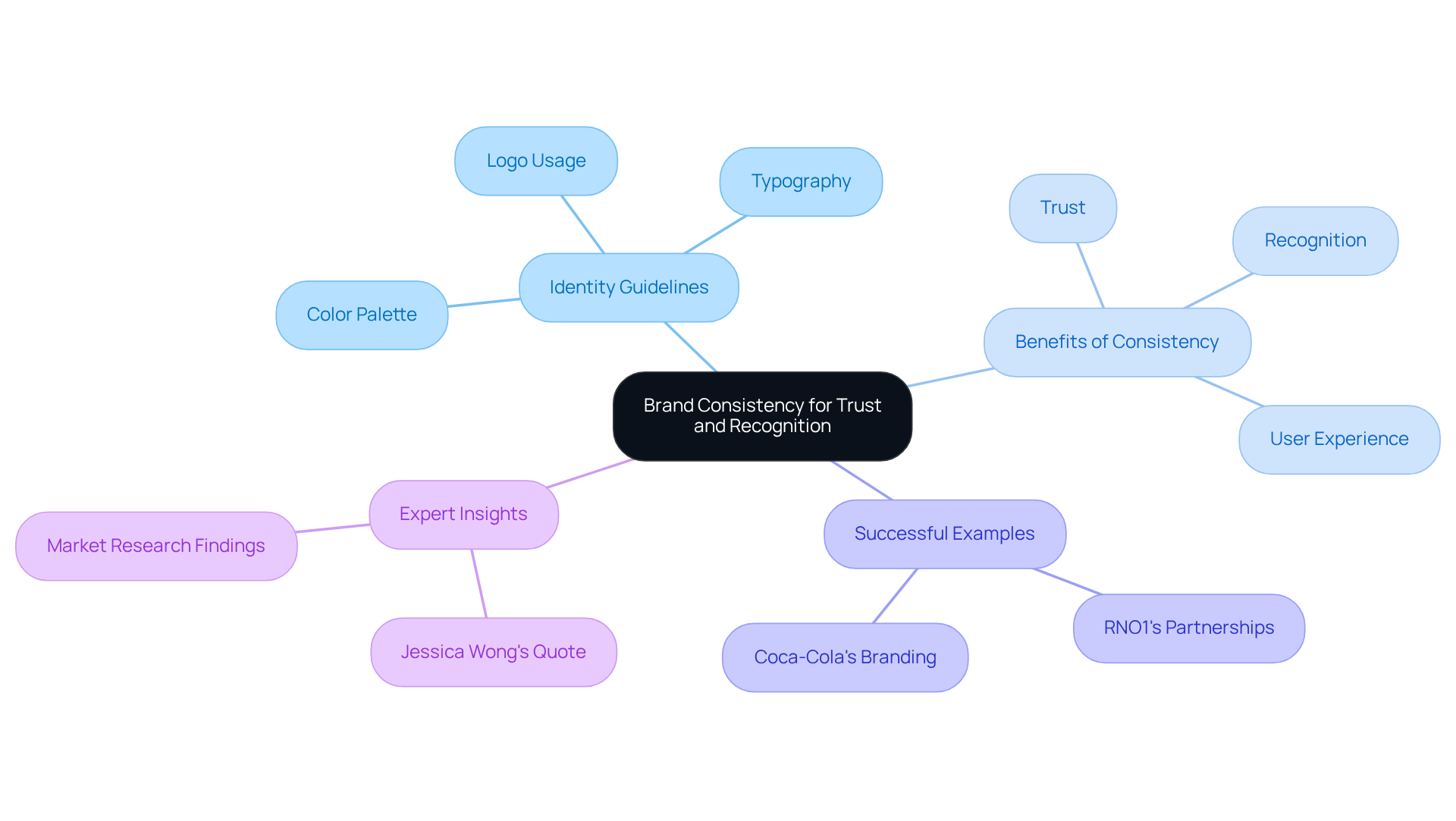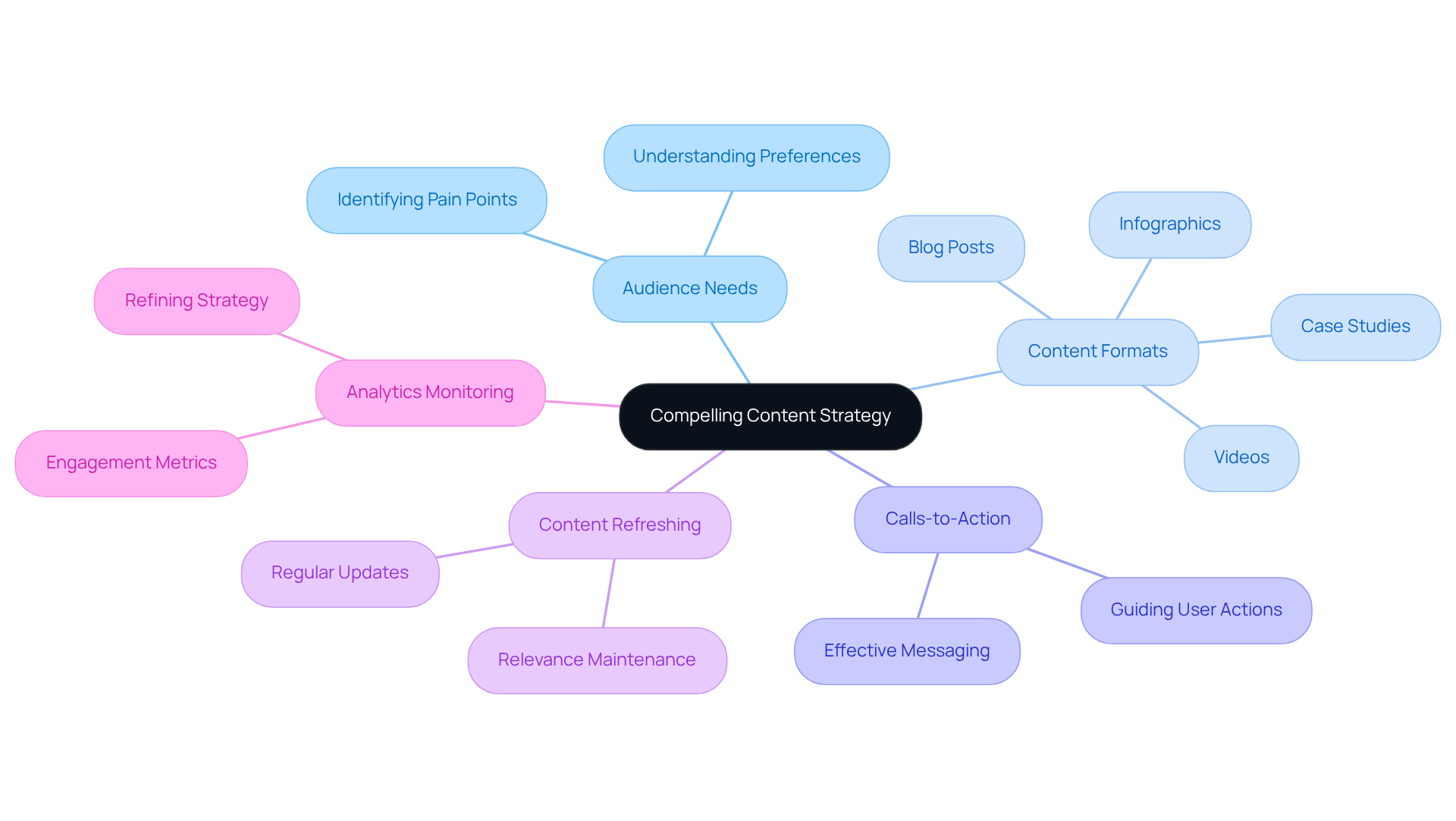Overview
In the competitive landscape of tech startups, many founders struggle with establishing a strong online presence. This challenge can lead to feelings of frustration and doubt, as they wonder how to effectively convey their brand's identity and connect with their audience. The good news is that there are proven practices that can transform their approach to website branding and design.
Firstly, defining a clear brand identity is crucial. It serves as the foundation for all branding efforts, ensuring that every element of the website resonates with the intended message. When founders take the time to articulate their brand’s values and mission, they not only clarify their vision but also foster a deeper connection with their audience.
Next, creating a clear website structure can alleviate confusion for visitors. A well-organized site guides users effortlessly through the content, enhancing their experience and encouraging them to engage more deeply. This clarity can significantly reduce the anxiety that often accompanies navigating a new site, making users feel more at ease.
Consistency across brand elements is another vital practice. When colors, fonts, and messaging align, it builds trust and familiarity. This consistency reassures visitors that they are in the right place, reinforcing their decision to explore further. It’s this sense of reliability that can turn casual visitors into loyal customers.
Finally, producing compelling content is essential for driving engagement. By sharing stories, insights, and valuable information, tech startups can resonate with their audience on a personal level. This not only captivates visitors but also encourages them to return, fostering a supportive community around the brand.
By embracing these best practices, tech startups can enhance their online presence, build trust, and ultimately create a brand that truly resonates with their audience. It’s a journey worth taking, and with the right support, they can navigate it successfully.
Introduction
Creating a compelling online presence is essential for tech startups striving to stand out in a crowded digital landscape. Many founders face the challenge of effectively branding their websites, which not only reflects their company’s identity but also resonates with their target audiences. This connection fosters trust and engagement. Yet, it’s common for these founders to struggle with the intricacies of defining their brand and ensuring consistency across various platforms. This can lead to feelings of frustration and uncertainty.
How can they navigate these challenges to create a website that captivates visitors and drives conversions? By understanding these pain points, we can begin to explore supportive solutions that not only address these issues but also empower founders to build a strong online presence. At RNO1, we believe in nurturing your vision and guiding you through this process, ensuring that your brand shines brightly in the digital world.
Define Your Brand Identity for Effective Website Branding
Creating a strong online identity can feel overwhelming for many tech startup founders. You might find yourself grappling with how to define your mission, vision, values, and unique selling propositions (USPs). It’s not just about having a website; it’s about crafting website branding and design that truly reflects who you are and resonates with your audience. The challenge lies in understanding your target market and their preferences. Conducting thorough market research can provide valuable insights, helping you visualize your ideal customers through tools like customer personas. This step is crucial in ensuring that your branding speaks to them on a personal level.
Once you have a clear identity, integrating it into your website branding and design elements becomes essential. Think about how color schemes, typography, and imagery can convey your brand’s essence. For example, a tech startup may choose a sleek, minimalist design to evoke innovation and sophistication, while a lifestyle company might opt for vibrant colors and playful fonts to express fun and creativity. This connection between your identity and website branding and design not only enhances the visitor experience but also creates a unified presence that truly resonates with your audience.
Statistics reveal that:
- 94% of first impressions are design-related, highlighting the importance of website branding and design in creating a well-crafted visual identity.
- 57% of users wouldn’t recommend a company that lacks good website branding and design, underscoring the vital role effective marketing plays in your success.
- 81% of consumers feel that a company’s handling of personal data reflects its respect for customers, emphasizing the need for authenticity in your marketing efforts.
RNO1’s partnerships with industry leaders like Microsoft and Airbnb illustrate how strategic collaborations can drive digital brand innovation and growth. Our work with Airbnb, for example, significantly enhanced their digital presence, showcasing the impact of effective marketing. As Courtney Bozigian, Head of Brand Development, wisely states, "To remain competitive, foster customer loyalty and drive long-term success, companies must prioritize strategic branding efforts."
By prioritizing these elements and implementing Return On Design & Digital (RODD) strategies, tech startups can differentiate themselves in a competitive landscape and build lasting connections with their audience. Remember, you’re not alone in this journey; RNO1 is here to support you every step of the way.

Create a Clear Website Structure to Enhance User Experience
To enhance visitor experience, it’s important to establish a clear and logical website structure. Many tech startup founders face the challenge of ensuring their site is easy to navigate, which can significantly impact user satisfaction. Imagine a potential client arriving at your site, only to feel lost in a maze of information. This is a common pain point that can lead to frustration and, ultimately, lost opportunities.
Begin by mapping out the main sections of your site—like Home, About, Services, and Contact—using a hierarchical approach to organize content effectively. This thoughtful organization ensures that related information is clustered together, facilitating easier access for your visitors. A straightforward navigation menu can make all the difference, allowing individuals to reach key areas of your site with minimal clicks. For instance, a tech startup might structure its site to include sections for product features, case studies, and customer testimonials, clearly showcasing the value offered to potential clients.
Incorporating breadcrumbs can further assist visitors in tracking their location within the site, enhancing their navigation experience. Regularly evaluating your site’s navigation with real users is crucial. It helps to pinpoint issues and implement necessary modifications. A survey by Clutch revealed that 94% of individuals identified easy navigation as their most preferred aspect of a site’s design, underscoring its importance in retaining visitors. Moreover, a well-organized online platform can lead to a 74% increase in conversions when load times are optimized, illustrating the direct impact of effective navigation on business success.
As Daniel Kodam, a tech founder, wisely states, 'UX/UI is the backbone of a strong application,' emphasizing the significance of intuitive design principles. Furthermore, 88% of online shoppers are less inclined to return to a site after a poor experience, highlighting the necessity for effective navigation. By prioritizing a logical online structure and friendly navigation, tech startups can significantly enhance engagement and satisfaction, ultimately driving growth and success. However, neglecting this aspect can lead to pitfalls like overcrowded menus and unclear pathways, which can frustrate users and contribute to higher bounce rates.
By addressing these concerns with empathy and understanding, we can help foster a supportive environment for tech startup founders, guiding them toward creating a user-friendly experience that resonates with their audience.

Ensure Consistency Across Brand Elements for Trust and Recognition
Building trust and recognition can be a daunting task for tech startup founders. It’s essential to maintain consistency across all elements of your identity—this includes your website branding and design, social media profiles, and marketing materials. Imagine how comforting it would be for your audience to see a cohesive color palette, typography, and logo across all platforms, creating a unified company image. This is where thorough identity guidelines come into play. They should clearly specify the proper usage of your identity elements. For instance, if your company showcases a specific shade of blue in its logo, that color should consistently appear in website branding and design, including buttons, headings, and promotional materials.
Such consistency not only reinforces your identity but also enhances the user experience by focusing on website branding and design. Visitors feel more comfortable navigating a site that showcases effective website branding and design with familiar visuals. Regular evaluations of your promotional materials are crucial to ensure compliance with these guidelines. In fact, 60% of firms report that a uniform identity contributes to a 10-20% increase in growth.
Successful examples abound, such as RNO1's partnerships with Interos and Amount. These collaborations demonstrate that maintaining a uniform visual identity fosters trust and enhances recognition. As Jessica Wong, founder of Valux Digital, wisely notes, 'Maintaining consistency in website branding and design fosters trust, enhances recognition, and boosts customer loyalty in every sector.' By prioritizing brand consistency, tech startups can effectively build trust and establish a strong market presence. RNO1's transformative collaborations have driven significant digital growth, proving that a caring approach to branding can make all the difference.

Produce Compelling Content to Drive Engagement and Conversions
To foster a deeper connection and encourage conversions, it’s essential to focus on crafting high-quality, relevant content that truly resonates with your target audience. Many startup founders face the challenge of engaging their audience effectively, often feeling overwhelmed by the need to create content that not only informs but also captivates. By identifying key topics that address your audience's needs and pain points, you can create content that is both informative and engaging, nurturing a sense of understanding and support.
Consider utilizing a variety of formats—such as blog posts, videos, infographics, and case studies—to cater to the diverse preferences of your audience. For instance, a tech startup might share a series of blog posts that delve into their product's features, complemented by video tutorials that showcase practical applications. This approach not only provides valuable insights but also invites your audience to engage with your brand on multiple levels.
Incorporating compelling calls-to-action (CTAs) within your content is crucial for guiding users toward desired actions, whether that’s signing up for a demo, downloading a whitepaper, or making a purchase. It’s important to regularly refresh your content to keep it relevant and appealing. By leveraging analytics tools to monitor engagement metrics, you can gain valuable insights that help refine your content strategy, ensuring it stays aligned with your audience's interests and maximizes conversion potential.
Successful examples in digital marketing highlight the importance of adapting content to meet evolving consumer expectations. By nurturing these connections, you not only foster stronger relationships but also drive meaningful business growth. Remember, you’re not alone in this journey; many founders share similar experiences, and together, we can navigate the challenges of engaging your audience effectively.

Conclusion
Creating an effective website that embodies strong branding and design principles can feel overwhelming for tech startups striving to connect with their audience. It’s not just about aesthetics; a well-defined brand identity significantly shapes how potential customers perceive and interact with a business. When branding and website design align, startups can foster deeper connections and create a memorable online presence that resonates with users.
Many founders struggle with establishing a clear website structure, ensuring consistency across branding elements, and producing compelling content. These challenges can lead to a disjointed user experience that hinders engagement. A logical website layout facilitates navigation, while uniform branding builds trust and recognition. Moreover, high-quality content tailored to the audience's needs can significantly impact conversions, making it imperative for startups to prioritize these elements in their digital strategy.
Ultimately, the journey of building a successful online brand is about creating an engaging experience that truly resonates with users. By implementing these best practices, tech startups can differentiate themselves in a crowded market and cultivate lasting relationships with their audience. Embracing these strategies not only paves the way for growth but also nurtures a supportive community in the ever-evolving digital landscape.
Frequently Asked Questions
What is the importance of defining brand identity for a website?
Defining brand identity is crucial for tech startup founders as it helps in crafting website branding and design that reflects their mission, vision, values, and unique selling propositions (USPs), resonating with their target audience.
How can market research assist in defining brand identity?
Conducting thorough market research provides valuable insights into target market preferences, helping founders visualize their ideal customers through tools like customer personas, ensuring that their branding speaks to the audience on a personal level.
What elements should be considered when integrating brand identity into website design?
Key elements to consider include color schemes, typography, and imagery, which should convey the brand's essence and enhance the visitor experience, creating a unified presence that resonates with the audience.
What statistics highlight the importance of website branding and design?
Statistics show that 94% of first impressions are design-related, 57% of users wouldn’t recommend a company lacking good branding, and 81% of consumers believe a company’s handling of personal data reflects its respect for customers.
How can strategic partnerships impact digital brand innovation?
Strategic partnerships, such as those with industry leaders like Microsoft and Airbnb, can drive digital brand innovation and growth, as demonstrated by RNO1's work with Airbnb, which significantly enhanced their digital presence.
What is the Return On Design & Digital (RODD) strategy?
RODD strategies prioritize effective branding efforts, allowing tech startups to differentiate themselves in a competitive landscape and build lasting connections with their audience.
How can RNO1 assist tech startups in their branding journey?
RNO1 is available to support tech startups by providing guidance and resources to help them navigate the challenges of defining their brand identity and implementing effective branding strategies.




